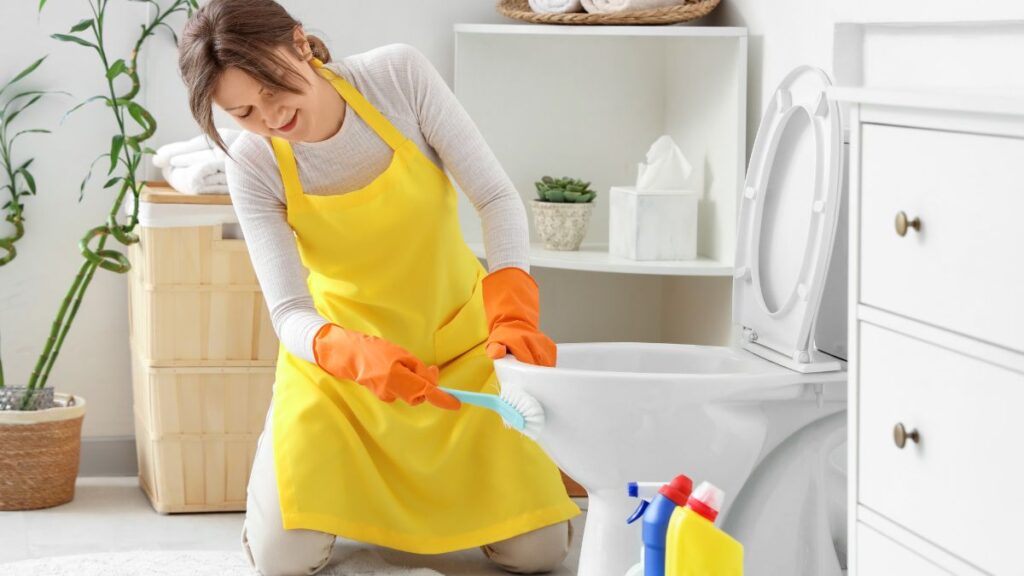
Stepping into a bathroom should feel refreshing, yet persistent patches of mold can turn the experience into a daily frustration. Even the most diligent homeowners face recurring bathroom mold removal challenges at some point in the year.

Quick Daily Bedroom Reset in Under 15 Minutes
Transform your space fast! Follow this 15-minute daily bedroom reset to keep things tidy, calm, and clutter-free.
Addressing bathroom mold goes beyond surface cleaning; unchecked, it damages grout, compromises air quality, and poses health risks. Knowing reliable techniques for bathroom mold removal keeps your space hygienic and inviting.
Effective bathroom mold removal isn’t about quick fixes. Take a closer look at these proven strategies to stop mold from coming back, maintain a cleaner home, and promote peace of mind all year long.
Tackle Moisture at Its Source for Long-Term Results
Mold thrives where there’s consistent dampness. For bathroom mold removal that genuinely sticks, it’s crucial to break the cycle of bathroom humidity from the start.
Start by identifying the common culprits: steamy showers, leaky fixtures, and poor ventilation feed mold growth. Addressing these makes bathroom mold removal more effective.
Ventilate the Right Way Each Day
If your bathroom feels stuffy or you notice wet walls long after a shower, upgrade your ventilation. Open a window a crack every day, or run an exhaust fan for at least 20 minutes post-shower.
Sometimes, moisture lingers under vanity counters or in corners the fan can’t reach. Place a small, portable fan aimed toward those damp zones to speed up evaporation and cut the mold’s water supply.
A practical step: set a timer when you start your shower. Leave it running until towels, mirrors, and tiles are bone-dry. This single routine can dramatically curb mold recurrence without extra chemicals.
Repair Leaks and Drips Immediately
Dripping faucets or under-sink leaks deliver a steady supply of water that mold loves. Check behind toilets, under vanities, and around tub fixtures for any signs of dripping.
Your nose helps too—musty odors often signal hidden leaks. Use plumber’s tape or silicone caulk for a quick patch, then call a pro if water stains reappear. Fixes done fast mean less cleaning in the future.
For renters, snap a photo of water pooling and email maintenance immediately. Even tiny fixes, handled quickly, stop mold colonies from taking hold. This proactive stance means less scrubbing and longer-lasting results.
| Moisture Source | Typical Problem Area | Detection Method | Action Step |
|---|---|---|---|
| Shower steam | Ceiling/corners | Condensation after use | Install/upgrade fan; dry manually |
| Faucet leaks | Under sink/baseboards | Check for pooling water | Fix or replace gaskets |
| Toilet sweat | Tank/below toilet | Look for drips/stains | Use insulation or drip trays |
| Poor window seals | Window frames | Feel for drafts/moisture | Apply weatherstripping |
| Bath mat dampness | Floor around tub/shower | Check mat underside | Hang to dry daily |
Use Cleaning Agents That Provide a Lasting Barrier
Choosing the right solution for bathroom mold removal can extend your results for weeks, not days. These agents don’t just wipe away spores—they form a barrier that repels future growth.
Choose products labeled “mold inhibitor” or mix DIY solutions with proven effects. Look for safe options that protect surfaces but avoid harsh smells and irritants.
Apply Mold-Fighting Solutions Weekly
A once-a-week spray across tubs, grout, and caulk keeps spores from finding a foothold. Work in sections for thorough coverage, using a microfiber cloth to press solution deep into crevices and corners.
- Spray hydrogen peroxide on visible mold, let it fizz, then scrub clean. The bubbling action penetrates grout and helps lighten stains.
- Use a vinegar-and-water mix to gently dissolve early mold clusters. Vinegar breaks down cell walls, making further cleanings much easier.
- Try a baking soda paste on tiled areas. It scours away residue and deodorizes, leaving surfaces less appealing for mold’s return.
- Choose a bathroom mold removal spray containing quaternary ammonium. These form an invisible barrier; always follow the label for safe handling.
- Finish by wiping down all surfaces until dry. Residual moisture undoes your work, so use a towel dedicated to this final drying stage.
A consistent routine means less elbow grease is needed in the future. Over time, these habits keep the “bathroom mold removal” task short and stress-free.
Seal Porous Surfaces Every Month
Bathroom tile, grout, and caulk naturally absorb water. After a deep clean, seal these spots with a water-repellent product monthly to limit new mold clusters.
- Choose a grout sealer specifically for bathrooms; aerosol sprays offer even coverage over tricky surfaces and corners.
- Press the nozzle close to grout lines, moving slowly to avoid streaks. Allow at least 12 hours for sealer to set before exposing to moisture.
- Regular checks with a flashlight help spot gaps in sealant. Reseal promptly where water beads no longer form, as these become entry points for spores.
- Replace old or crumbly caulk immediately. Peeling caulk is a magnet for mold and is easy to reseal in an afternoon with basic supplies.
- Jot down the sealing routine in a calendar app or on a sticky note near your bathroom supplies. This gentle reminder ensures barriers are always in place.
Most people notice an almost immediate drop in mold regrowth when they stick to a sealing schedule paired with regular bathroom mold removal techniques.
Focus on High-Risk Areas for Spotless Results
Zeroing in on the right bathroom zones makes bathroom mold removal much more efficient. Mold often hides where light and air rarely reach, so specific attention is key.
By isolating the high-risk spots, you can use time wisely while preventing the frustration of surprise mold bursts weeks later.
Grout and Silicone: Deep Cleaning for Lasting Impact
Inspect grout lines with a flashlight every Saturday morning. A firm toothbrush loaded with mold-specific cleaner gets into pores where sponges can’t reach.
After scrubbing small mosaic tiles or broad walls, rinse with warm water to lift away loosened mold. Towel dry, wait an hour, and apply a light sealer if needed.
If you smell that signature “swampy” scent near silicone caulk or notice it lifting, replace that section the same afternoon. Wear gloves, cut out the bad section, and smooth new caulk in one steady pass for best adhesion.
Shower Curtains and Liners: A Fast Refresh
Remove the shower curtain and liner monthly. Toss them into the washing machine with a couple bath towels—the towels scrub and prevent tangling during cycles.
Use a gentle, mold-fighting detergent and a cup of baking soda. Hang dry completely; bunched or damp curtains invite mold to return before the next cycle.
If replacing fabric liners feels overwhelming, switch to a vinyl liner with built-in mold protection. Wipe with vinegar each week for ongoing cleanliness—ensuring bathroom mold removal is a consistent, painless chore.
Commit to Consistency for a Mold-Free Bathroom
Long-lasting bathroom mold removal comes down to addressing dampness, cleaning proactively, and sealing vulnerable spots on a schedule, not guessing or scrambling when stains appear.
By concentrating efforts on source moisture, using the right cleaners, and tackling those hidden corners, bathrooms stay fresher all year. Small daily actions mean less hassle with deep cleaning or repairs.
Try one change from this guide—whether it’s drying surfaces, fixing a leak, or sealing grout this weekend. Every step builds a mold-resistant routine that pays off in peace of mind and better health.
Frequently Asked Questions
Weekly application is ideal, especially in humid bathrooms. If you see or smell mold sooner, step up to twice a week to break the cycle quickly.
Bleach kills surface mold but may not reach deeper roots in porous grout or caulk. Opt for hydrogen peroxide, vinegar, or dedicated mold removers for a safer, long-lasting solution.
Run an exhaust fan for 20 minutes after showers, open windows where possible, and towel-dry tiles, mirrors, and shower doors. Stack these habits for the best results.
If mirrors, walls, or cabinets always feel damp, or if there’s a musty smell even after cleaning, hidden leaks or poor ventilation may be to blame. Address immediately with repairs or fan upgrades.
Always air out the bathroom during cleaning and use nontoxic products listed as safe for children and pets. Store all cleaners securely and rinse surfaces well before letting anyone touch or use them.

Simple Lubrication Tips for Sliding Doors
Keep doors gliding smoothly! Follow these simple lubrication tips to fix sticking sliding doors fast. Read on and learn more!


